Download CBSE Class 8 Science Reproduction in Animals Notes in PDF format. All Revision notes for Class 8 Science have been designed as per the latest syllabus and updated chapters given in your textbook for Science in Class 8. Our teachers have designed these concept notes for the benefit of Class 8 students. You should use these chapter wise notes for revision on daily basis. These study notes can also be used for learning each chapter and its important and difficult topics or revision just before your exams to help you get better scores in upcoming examinations, You can also use Printable notes for Class 8 Science for faster revision of difficult topics and get higher rank. After reading these notes also refer to MCQ questions for Class 8 Science given on studiestoday
Revision Notes for Class 8 Science Chapter 9 Reproduction in Animals
Class 8 Science students should refer to the following concepts and notes for Chapter 9 Reproduction in Animals in Class 8. These exam notes for Class 8 Science will be very useful for upcoming class tests and examinations and help you to score good marks
Chapter 9 Reproduction in Animals Notes Class 8 Science
CBSE Class 8 Science Animal Reproduction Chapter Notes. Learning the important concepts is very important for every student to get better marks in examinations. The concepts should be clear which will help in faster learning. The attached concepts made as per NCERT and CBSE pattern will help the student to understand the chapter and score better marks in the examinations.
ANIMAL REPRODUCTION
REPRODUCTION IN ANIMAL
The process by which an organism produce offsprings is known as reproduction.
O R
The process by which living beings produce offspring of their own kind is called reproduction.
• Offsprings are genetically similar to their parents.
• Reproduction is necessary for the existence and continuity of species in universe.
Reproduction is of two types : (i) Asexual Reproduction (ii) Sexual Reproduction
ASEXUAL REPRODUCTION
Production of offsprings by a single parent without the formation and fusion of gametes is called asexual reproduction.
• It is a primitive type of reproduction.
• In this type of reproduction offspring is produced by a cell or any vegetative organ of an organism.
• In this type of reproduction offsprings are genetically identical to their parents.
Reproduction in Hydra :
• In this method an outgrowth (bud) is formed on the parent organism.
• The bud gradually grows in size and gets detached from the parent.
• Detached bud develops into an adult organism, similar to the parent
Other example :- Yeast
SEXUAL REPRODUCTION
Reproduction resulting from the fusion of male and female gametes is called sexual reproduction.
O R
The type of reproduction in which fusion of male & female gamete occur is called sexual reproduction.
Important features of sexual reproduction are given below :
(i) It involves two different parents i.e. one male and one female.
(ii) Each parent produces gametes.
(iii) Male gametes are called sperms while female gametes are called ova or eggs.
(iv) The fusion of male and female gametes is called fertilization. It results in to the formation of a single diploid cell zygote.
(v) The zygote undergoes repeated mitotic divisions to form embryo which differentiate to form full organism.
(vi) The organisms produced in this type of reproduction are genetically different from both the parents and can resemble in certain features with parents
Types of animals on the basis of presence of sex organs :
(a) Unisexual Animals : Those animals in which male and female sexes remain separate e.g. Human beings, Cow, Cat, Dog.
(b) Bisexual Animals : • Those animals in which male and female sex organs are present in single body are called bisexual or
hermaphrodite e.g. Earthworm, Taenia solium, Leech
HUMAN REPRODUCTIVE SYSTEM
Male Reproductive organs : The male reproductive system of humans consists of the following organs.
(1) Testes (2) Vas deferens (3) Urethra (4) Penis
Testes: There is a pair of testes which lie outside the body within the scrotum. They produce millions of sperms.
Vas deferens: Vas deferens are two in numbers. This duct connects each testis to the urethra. It carries sperms to the urethra alongwith the secretion of reproductive glands. This mixture of sperms and secretions is called semen.
Urethra: The two vas deferens open into the urethra and pass through the penis.
Penis: Urethra leads to a muscular organ called penis. It is used to deliver semen into the vagina of the female during mating. It is used to pass urine as well.
The main function of testes is to produce sperms.
Sperm : It consists of the following parts : (i) Head (ii) Neck (iii) Middle piece (iv) Tail
The sexual maturity in human males is attained around the age of 13 to 14 years. Sperms are produced in millions by the testes. They are very small in size. Each sperm consists of a head, a middle piece and a tail. Sperms swim in semen with the help of a tail.
Female Reproductive Organ : The female reproductive system of humans consists of the following organs.
(1) Ovaries (2) Oviduct (fallopian tube) (3) Uterus (4) Vagina
1. Ovaries : There are two ovaries which are situated in the abdominal cavity. Each ovary produces one mature ovum (egg) every month by a process called ovulation. Like sperm, an egg is also a single cell.
2. Oviduct (fallopian tube) : It is a muscular tube which joins the uterus with the ovary. It carries the ovum into the uterus.
3. Uterus : It is a hollow, muscular, pear-shaped organ. The development of the baby takes place inside it. The lower narrow part of the uterus is called cervix.
4. Vagina : The uterus opens into a wide muscular tube called vagina. The vagina receives the penis during sexual intercourse. The sperms are discharged into the vagina.
Ovary start producing female gametes called ova when a girl reaches puberty at 10-12 years. Uterus is the organ where the zygote matures and grows till it is ready to be born. It is also known as womb.
REVIEW QUESTIONS
VERY SHORT ANSWER TYPE QUESTIONS
1. What is reproduction ?
Answer.Zygote
2. Define Asexual Reproduction.
Answer.Binary fission
3. What are unisexual and bisexual animals ?
Answer.Sexual Reproduction
4. What is puberty ?
Answer.Reproduction
5. What is main function of testes ?
Answer.Abdominal cavity
SHORT ANSWER TYPE QUESTIONS
1. Explain binary fission in Amoeba.
2. Mention the characteristic features of sexual reproduction.
3. Explain Asexual reproduction in Hydra with labelled diagram.
4. Draw a labelled diagram of male reproductive system.
5. Name the parts present in human sperm. Show by labelled diagram.
EXPLAIN WHY?
1. In Asexual reproduction offsprings are genetically similar to their parents.
2. In sexual reproduction offsprings are different from their parents.
FILL IN THE BLANKS
1. The cell which is obtained by the fusion of male & female gamete is known as ..................
2. A type of asexual reproduction in which an animal reproduces by dividing into two individuals is called ..................
3. The type of reproduction in which fusion of male & female gamete occur is called ..................
4. .................. is necessary for the existence and continuity of species in universe.
5. Ovary lie in the lower part of the ..................
Fertilization :
1. The sperms introduced into the vagina, during sexual intercourse, travel up the vagina and uterus, into the fallopian tube.
2. Fertilization takes place in fallopian tube.
3. The fusion of male & female gamete is called fertilization and the cell formed after fusion of male & female gametes is called zygote.
4. During fertilization, the nuclei of the sperm and egg fuse to form a single diploid nucleus.
5. In the process of fertilization an egg cell from the mother meets with a sperm cell from the father. Hence the new individual obtain some characters from the mother and some from the father.
6. Zygote is the first cell of new individual.
TEST TUBE BABY OR IN VITRO FERTILISATION (IVF)
Test tube baby is the main achievement of biotechnology in human welfare. In some women oviducts are blocked. These women are unable to bear babies because sperms cannot reach the egg for fertilization. In such cases, doctors collect freshly released egg and sperms & keep them together for a few hours for IVF or Invitro fertilization [Fertilization outside the female body]. This whole process is completed outside the body of the female, in the laboratory. The process of cleavage starts in the fertilized egg and then it is transplanted into the uterus of the female, where it undergoes normal development. Test tube baby is a baby obtained by normal development in uterus of the female but after in-vitro fertilization in the lab. The first test tube baby of the world, Louise Joy Brown was born on 25th July, 1978 in Britain. The first test tube baby of India "Harsha" was born in 1986.
Types of fertilization :
(a) Internal Fertilization :
The type of fertilization in which fusion of male & female gamete takes place in side the female body. e.g. Human, Cow, Dog, Hen.
(b) External fertilization :
The type of fertilization in which fusion of male & female gamete takes place outside the body of the female.It is very common in aquatic animals like Starfish, Fish.
Aquatic animals lay hundreds of eggs and release millions of sperms, all the eggs do not get fertilized and develop into new individuals. This is because the eggs and sperms get exposed to water movement, wind & rain fall.Also, there are other animals in to the pond which may feed on eggs. Thus, production of large number of eggs and sperm is necessary to ensure fertilization of at least a few of them.
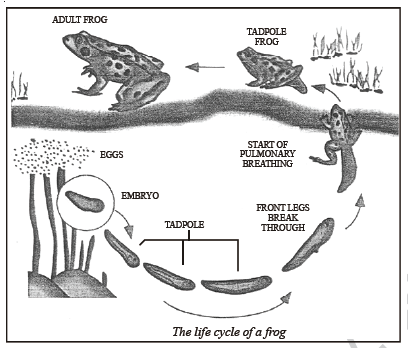
Differences between External and Internal Fertilization :
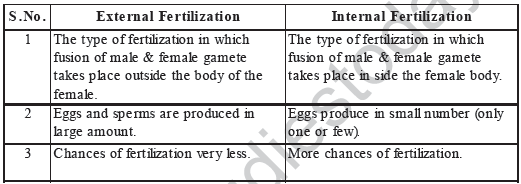
POINTS TO BE REMEMBER
(1) Asexual reproduction : The type of reproduction in which only a single parent is involved.
(2) Budding : It is a type of asexual reproduction which can be seen in Hydra. In this reproduction, the new individual develops from the buds.
(3) Binary fission : It is a type of asexual reproduction which can be seen in Amoeba. In this reproduction, an animal reproduces by dividing into two individuals.
(4) The ovary produces female gametes called ova and the testes produce male gametes called sperms.
(5) The fusion of ovum and sperm is called fertilization. The fertilized egg is called a Zygote.
(6) The stage of the embryo in which all the body parts are identifiable is called foetus.
(7) During spring or rainy season, frogs and toads move to ponds and slow flowing streams. When the male and female frog come together in water, the female lays hundreds of eggs. As the eggs are laid, the male deposits his sperms over them.
(8) Frog's egg is not covered by a shell and they are very delicate. A layer of jelly holds them together and provides protection to the eggs.
(9) Sperm of frog swims randomly in water with the help of its long tail.
(10) Each of the gamete contains one half of the hereditary characters from its parent.
The zygote has one complete set of hereditary characters - one half each from the mother and the father.
Development of embryo :
Fertilization results in the formation of zygote which begins to develop in to an embryo.
The zygote divides repeatedly to give rise to a ball of cells. The cells then begins to form groups that develop into different tissues and organs of the body. This developing structure is termed as embryo. The embryo attaches itself to the uterus wall with the help of placenta and gets embedded in the wall of the uterus for further development.
The embryo continues to develop in the uterus. It gradually develops body parts such as hands, legs, head, eyes, ears etc. The stage of the embryo in which all the body parts can be identified is called a foetus.
During this period of pregnancy, the baby takes nourishment from the mother through the placenta and the umbilical cord. The uterus increases in size as the foetus grows. The uterus is filled with a fluid called amniotic fluid that protects the foetus from jerks and change in temperature.
When the development of foetus is complete the mother gives birth to the baby.
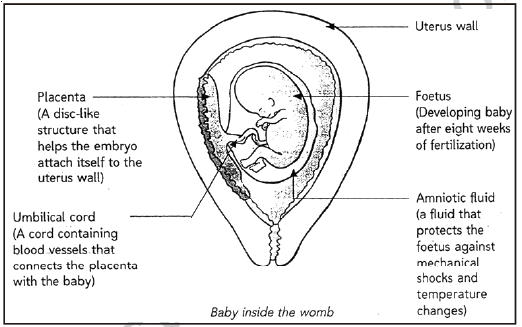
Viviparous & Oviparous animals :
Those animals which give birth to young ones are called viviparous animals. e.g. Man, Dog, Elephants.
Those animals which lay eggs are called oviparous animals. e.g. Frog, Snake, Lizards, Fish, Butterfly or Moth, Birds.
Young ones to Adults :
The new individuals which are born or hatched from the eggs continue to grow till they become adults.
In some animals, the young ones may look very different from the adults.
e.g. Life cycle of silk worm :-
Egg → Larva or caterpillar → Pupa → Adult
Life cycle of Frog :
Egg → Tadpole (Larva) → Adult
Metamorphosis : The transformation of the larva into an adult through drastic changes is called metamorphosis.
DOLLY : CLONE
Cloning is the production of an identical cell or any other living part or a complete organism. Cloning of animal was successfully performed for the first time by Ian Wilmut and his colleagues at the Roslin Institute in Edinburgh, Scotland. They cloned successfully a sheep named Dolly. Dolly was born on 5th July 1996 and was the first mammal to be cloned.
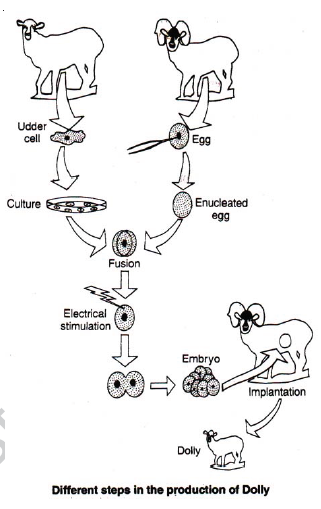
During the process of cloning Dolly, a cell was collected from the mammary gland of a female Finn Dorsett sheep. Simultaneously, an egg was obtained from a Scottish blackface ewe. The nucleus was removed from the egg. Then, the nucleus of the cell from the Finn Dorsett sheep was inserted into the egg of the Scottish blackface ewe. The egg thus produced was implanted into the Scottish blackface ewe. Development of the egg followed normally and finally Dolly was born. Though Dolly was given birth by the Scottish blackface ewe, it was found to be identical to the Finn Dorsett sheep from which the nucleus was taken. Since the nucleus of the Scottish blackface ewe was removed, Dolly did not show any character of the Scottish blackface ewe. Dolly was a healthy clone and produced several offsprings of her own through normal sexual means. Unfortunately, Dolly died on 14th February 2003 due to a certain lung disease.
Since Dolly, several attempts have been made to produce cloned mammals. However, many die before birth or die soon after birth. The cloned animals are also found to be born with severe abnormalities.
DO YOU KNOW ?
(1) Testes and ovary produce gametes as well as sex hormones.
Testes → Male sex hormone → Testosterone
Ovary → Female sex hormones → Estrogen and progesterone.
(2) New born babies may require up to 16 - 17 hours of sleep a day.
(3) Puberty is the stage at which a person attains sexual maturity or becomes capable of reproduction.
(4) The testes lie in a sac, called the scrotal sac, which is located outside the abdominal cavity.
(5) The wall of the uterus has a rich supply of blood vessels from which the growing embryo draws nutrition.
(6) The structure by which an embryo attached with uterine wall is called placenta. Through placenta embryo obtains nutrients and oxygen from mother.
(7) Umbilical cord : A cord that connects the placenta with the baby.
(8) The baby [embryo] grows in the mother's uterus for about nine months. This period is called gestation period or pregnancy.
EXERCISE-1
VERY SHORT ANSWER TYPE QUESTIONS
1. Where does fertilization take place ?
2. What is a foetus ?
3. How is an embryo produced ?
4. What is a zygote ?
5. Write three examples of animals in which external fertilization occur.
SHORT ANSWER TYPE QUESTIONS
1. What are the parts of a male reproductive system ?
2. Define metamorphosis.
3. How is internal fertilization differ from external fertilization ?
4. Define fertilization.
5. How does a sperm differ from an ovum ?
6. Draw a labelled diagram of female reproductive system.
7. What are oviparous & viviparous animals ?
8. Write a note on test tube baby in brief.
9. Write a note on Dolly in brief.
10. Describe the process of development from zygote to foetus in brief.
LONG ANSWER TYPE QUESTIONS
1. Describe the process of fertilization in human beings.
2. Give the functions of the following :
(i) Ovaries (ii) Testes (iii) Urethra (iv) Uterus (v) Oviducts.
REASONING ANSWER TYPE QUESTIONS
1. Why do female frogs produce eggs in large number ?
2. "Sexual reproduction is more advance than asexual reproduction" Why ?
3. How foetus is different from embryo ?
4. In which female reproductive organ does the embryo get embedded and why ?
5. How could a single cell become such a big individual ?
Question. Binary fission occurs in :
(A) Amoeba
(B) Paramecium
(C) Planaria
(D) All of these
Answer : D
Question. Which one of the following is concerned with asexual reproduction ?
(A) Zygote
(B) Spores
(C) Gametes
(D) Gonads
Answer : B
Question. Which type of reproduction of Hydra is most common ?
(A) Budding
(B) Cracking
(C) Sexual reproduction
(D) Gametogenesis
Answer : A
Question. The most fundamental characteristics of living being :-
(A) Movement
(B) Growth
(C) Fragmentation
(D) Reproduction
Answer : D
Question. Multiple fission occurs in :-
(A) Hydra
(B) Plasmodium
(C) Planaria
(D) All of these
Answer : B
Question. Egg laying animals are known as :-
(A) Viviparous
(B) Oviparous
(C) Sterile
(D) Hermaphrodite
Answer : B
Question. Animals which give birth to young ones are called :-
(A) Amphibious
(B) Oviparous
(C) Triploblastic
(D) Viviparous
Answer : D
Question. Testes of rabbit occur :-
(A) Inside body
(B) Upper side of kidney
(C) On either side of dorsal aorta
(D) In scrotal sacs
Answer : D
Question. Fertilization of ovum takes place in :-
(A) Ovary
(B) Fallopian tube
(C) Cervix
(D) Uterus
Answer : B
Question. Oogenesis is a process of formation of :-
(A) Sperms
(B) Ova
(C) Sperms and ova
(D) Oocytes
Answer : B
Question. Middle piece of a mammalian sperm contains :-
(A) Nucleus
(B) Acrosome
(C) Vacuole
(D) Mitochondria
Answer : D
Question. Male hormone is :-
(A) Corpus luteum
(B) Testosterone
(C) Progesterone
(D) Gonadotropin
Answer : B
Question. Sperms move by :-
(A) Head
(B) Acrosome
(C) Middle piece
(D) Tail
Answer : D
Question. Which type of cell division involve in asexual reproduction?
(A) Meiosis
(B) Mitosis
(C) Amitosis
(D) Both (A) & (B)
Answer : B
Question. Which type of cell division involve in sexual reproduction?
(A) Meiosis
(B) Mitosis
(C) Amitosis
(D) Both (A) & (B)
Answer : D
Question. Vegetative reproduction is a modified form of :
(A) Sexual reproduction
(B) Asexual reproduction
(C) Both (A) & (B)
(D) None of these
Answer : B
Question. The process of releasing of sperm by male organism during copulation is called :
(A) Ejaculation
(B) Insemination
(C) Fertilization
(D) Partuirition
Answer : A
Question. What is main reason of female gamete having large size?
(A) To increase the chances of meeting of male gamete with female gamete.
(B) To decrease the chances of meeting of male gamete with female gamete.
(C) To implantation of embryo.
(D) None of the above.
Answer : A
Question. How many sperms take part in fusion with female gamete :
(A) Only one
(B) Two
(C) Millions in number
(D) None of these
Answer : A
Question. Which of the following is correct?
(A) Fertilization is a by-chance process.
(B) Fertilization may occure inside or outside the female body.
(C) It is the fusion of two types of gamete (male of female)
(D) All the above.
Answer : D
Question. Which of the following is wrong about birth of Dolly?
(A) The nucleus was taken by udder cells of a female Finn Dorsett sheep.
(B) A egg was obtained from Scottish blackface ewe.
(C) Dolly was identical to the Finn Dorsett sheep.
(D) None of these
Answer : D
Question. During In-vitro fertilization, the process of fertilization, occurs in :
(A) Uterus
(B) Fellopian tube
(C) Test Tube in laboratory [outside the body]
(D) Water [out side the body]
Answer : C
Question. During metamorphosis :
(A) Tadepole change into adult
(B) Pupa of silk worm change into adult
(C) Human child change into adult
(D) Both (A) & (B)
Answer : D
Question. Binary fission is a form of :-
(A) Sexual reproduction
(B) Asexual reproduction
(C) Both of these
(D) None of these
Answer : B
Question. Fertilization of frog takes place in :-
(A) Uterus
(B) Fallopian tube
(C) Water
(D) Upper part of oviduct
Answer : C
FILL IN THE BLANKS
Question. The .................... is also called womb.
Answer : Uterus
Question. The .................... is primary reproductive organ in male.
Answer : Testes
Question. The .................... is connecting structure which helps in the transfer of substance to and from the foetus body.
Answer : Placenta
Question. The process of laying eggs in large number is called ....................
Answer : Superovulation
Question .................... is the primary reproductive organ in female.
Answer : Ovary
Question. Testes produce ....................
Answer : Sperms
Question. The cells involved in sexual reproduction are called ....................
Answer : Gametes
Question. In animals like fish and frog .................... fertilisation takes place.
Answer : External
Question. The human zygote gets implanted in the ....................
Answer : Uterus
Question. IVF stands for ....................
Answer : In vitro fertilization
CHOOSE TRUE AND FALSE STATEMENTS FROM FOLLOWINGS
Question. Internal fertilisation takes place outside the female's body.
Answer : FALSE
Question. Birds and snakes are oviparous animals.
Answer : TRUE
Question. A tadpole is the young one of a frog.
Answer : FALSE
Question. Animals like Amoeba multiply by budding.
Answer : FALSE
Question. The fusion of male and female sex cells is called fertilisation.
Answer : TRUE
MATCH THE ITEMS IN COLUMN A WITH THE ITEMS IN COLUMN B
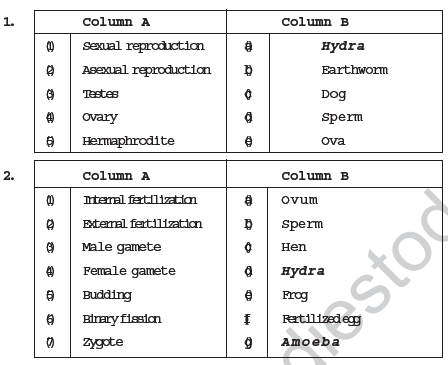
Answer : 1. (1) → c ; (2) → a ; (3) → d ; (4) → e ; (5) → b.
2. (1) → c ; (2) → e ; (3) → b ; (4) → a ; (5) → d ; (6) → g ; (7) → f
EXERCISE-2
OBJECTIVE TYPE QUESTIONS
Question. Binary fission occurs in :
(A) Amoeba
(B) Paramecium
(C) Planaria
(D) All of these
Answer.D
Question. Which one of the following is concerned with asexual reproduction ?
(A) Zygote
(B) Spores
(C) Gametes
(D) Gonads
Answer.B
Question. Which type of reproduction of Hydra is most common ?
(A) Budding
(B) Cracking
(C) Sexual reproduction
(D) Gametogenesis
Answer.A
Question. The most fundamental characteristics of living being :-
(A) Movement
(B) Growth
(C) Fragmentation
(D) Reproduction
Answer.D
Question. Multiple fission occurs in :-
(A) Hydra
(B) Plasmodium
(C) Planaria
(D) All of these
Answer.B
Question. Egg laying animals are known as :-
(A) Viviparous
(B) Oviparous
(C) Sterile
(D) Hermaphrodite
Answer.B
Question. Animals which give birth to young ones are called :-
(A) Amphibious
(B) Oviparous
(C) Triploblastic
(D) Viviparous
Answer.D
Question. Testes of rabbit occur :-
(A) Inside body
(B) Upper side of kidney
(C) On either side of dorsal aorta
(D) In scrotal sacs
Answer.D
Question. Fertilization of ovum takes place in :-
(A) Ovary
(B) Fallopian tube
(C) Cervix
(D) Uterus
Answer.B
Question. Oogenesis is a process of formation of :-
(A) Sperms
(B) Ova
(C) Sperms and ova
(D) Oocytes
Answer.B
Question. Middle piece of a mammalian sperm contains :-
(A) Nucleus
(B) Acrosome
(C) Vacuole
(D) Mitochondria
Answer.D
Question. Male hormone is :-
(A) Corpus luteum
(B) Testosterone
(C) Progesterone
(D) Gonadotropin
Answer.B
Question. Sperms move by :-
(A) Head
(B) Acrosome
(C) Middle piece
(D) Tail
Answer.D
Question. Binary fission is a form of :-
(A) Sexual reproduction
(B) Asexual reproduction
(C) Both of these
(D) None of these
Answer.B
Question. Fertilization of frog takes place in :-
(A) Uterus
(B) Fallopian tube
(C) Water
(D) Upper part of oviduct
Answer.C
EXERCISE-3
Question. Which type of cell division involve in asexual reproduction?
(A) Meiosis
(B) Mitosis
(C) Amitosis
(D) Both (A) & (B)
Answer.B
Question. Which type of cell division involve in sexual reproduction?
(A) Meiosis
(B) Mitosis
(C) Amitosis
(D) Both (A) & (B)
Answer.D
Question. Vegetative reproduction is a modified form of :
(A) Sexual reproduction
(B) Asexual reproduction
(C) Both (A) & (B)
(D) None of these
Answer.B
Question. The process of releasing of sperm by male organism during copulation is called :
(A) Ejaculation
(B) Insemination
(C) Fertilization
(D) Partuirition
Answer.A
Question. What is main reason of female gamete having large size?
(A) To increase the chances of meeting of male gamete with female gamete.
(B) To decrease the chances of meeting of male gamete with female gamete.
(C) To implantation of embryo.
(D) None of the above.
Answer.A
Question. How many sperms take part in fusion with female gamete :
(A) Only one
(B) Two
(C) Millions in number
(D) None of these
Answer.A
Question. Which of the following is correct?
(A) Fertilization is a by-chance process.
(B) Fertilization may occure inside or outside the female body.
(C) It is the fusion of two types of gamete (male of female)
(D) All the above.
Answer.D
Question. Which of the following is wrong about birth of Dolly?
(A) The nucleus was taken by udder cells of a female Finn Dorsett sheep.
(B) A egg was obtained from Scottish blackface ewe.
(C) Dolly was identical to the Finn Dorsett sheep.
(D) None of these
Answer.D
Question. During In-vitro fertilization, the process of fertilization, occurs in :
(A) Uterus
(B) Fellopian tube
(C) Test Tube in laboratory [outside the body]
(D) Water [out side the body]
Answer.C
Question. During metamorphosis :
(A) Tadepole change into adult
(B) Pupa of silk worm change into adult
(C) Human child change into adult
(D) Both (A) & (B)
Answer.D
Please click the link below to download pdf file for CBSE Class 8 Science Animal Reproduction Chapter Notes.
| CBSE Class 8 Science Crop Production And Management Notes |
| CBSE Class 8 Science Microorganism Friend Or Foe Notes |
| CBSE Class 8 Science Synthetic Fibres And Plastics Notes |
| CBSE Class 8 Science Metal And Non Metals Notes |
| CBSE Class 8 Science Coal And Petroleum Notes |
| CBSE Class 8 Science Combustion and Flame Chapter Notes |
| CBSE Class 8 Science Conservation Of Plants And Animals Notes |
| CBSE Class 8 Science Cell Structure And Functions Notes |
| CBSE Class 8 Science Cell and Tissue Notes |
| CBSE Class 8 Science Reproduction And Cloning Notes |
| CBSE Class 8 Science Reproduction in Animals Notes |
| CBSE Class 8 Science Reaching The Age Of Adolescence Notes |
| CBSE Class 8 Science Force And Pressure Notes |
| CBSE Class 8 Science Friction Notes |
| CBSE Class 8 Science Sound Notes |
| CBSE Class 8 Science Chemical Effects of Electric Current Notes |
| CBSE Class 8 Science Some Natural Phenomena Notes |
| CBSE Class 8 Science Light Notes |
| CBSE Class 8 Science Stars and the Solar System |
| CBSE Class 8 Science Pollution of Air and Water Notes |
CBSE Class 8 Science Chapter 9 Reproduction in Animals Notes
We hope you liked the above notes for topic Chapter 9 Reproduction in Animals which has been designed as per the latest syllabus for Class 8 Science released by CBSE. Students of Class 8 should download and practice the above notes for Class 8 Science regularly. All revision notes have been designed for Science by referring to the most important topics which the students should learn to get better marks in examinations. Our team of expert teachers have referred to the NCERT book for Class 8 Science to design the Science Class 8 notes. After reading the notes which have been developed as per the latest books also refer to the NCERT solutions for Class 8 Science provided by our teachers. We have also provided a lot of MCQ questions for Class 8 Science in the notes so that you can learn the concepts and also solve questions relating to the topics. We have also provided a lot of Worksheets for Class 8 Science which you can use to further make yourself stronger in Science.
You can download notes for Class 8 Science Chapter 9 Reproduction in Animals for latest academic session from StudiesToday.com
Yes, the notes issued for Class 8 Science Chapter 9 Reproduction in Animals have been made available here for latest CBSE session
There is no charge for the notes for CBSE Class 8 Science Chapter 9 Reproduction in Animals, you can download everything free of charge
www.studiestoday.com is the best website from which you can download latest notes for Chapter 9 Reproduction in Animals Science Class 8
Come to StudiesToday.com to get best quality topic wise notes for Class 8 Science Chapter 9 Reproduction in Animals

